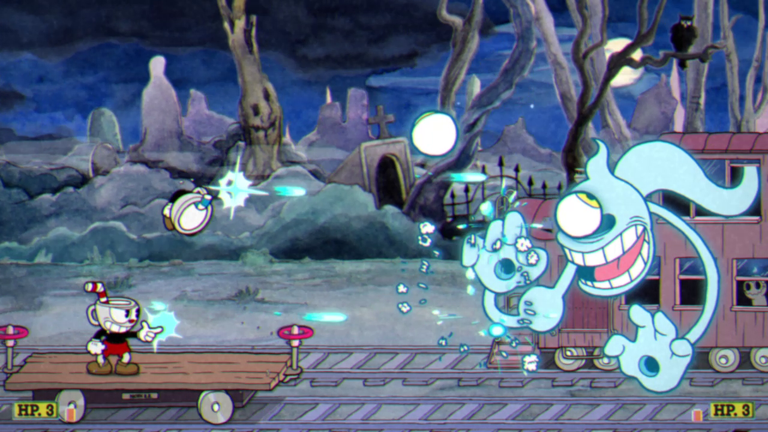

I recently completed Cuphead in Co-op, both the base game and the DLC, so you bet I have quite a few things to talk about the whole experience.
Cuphead sticks out on first impressions as this impressive looking game in regards to how it nails the feel of bouncy rubber hose cartoons and all bosses having a lot of animations as you fight them, which is also thanks to the painstakingly done effort of hand-drawing ALL those animations for extra authenticity [colored digitally for pracical purposes, but the effect still withstands].
...And then the next thing you'll notice when you get your hands on it is how it will put you through it, because Cuphead is a game that isn't just old-school in its presentation, but also in its difficulty - no punches pulled for most bosses.
That challenge is something that became trademark of Cuphead's reputation: You WILL die a lot to many bosses, but if you are willing to endure trial-and-error, practicing certain bosses and keeping your reflexes sharp, you can overcome all of it for a satisfying outcome, which is something key to a game that poses to offer a challenge and at first glance seems brutal for no reason.
But to go over that difficulty, I should talk first about what are the weapons for success you are given.
Shoot em up, parry the pink, don't touch anything
Both Cuphead and Mugman are surprisingly mobile compared to what you'd expect from hearing the game is like a run-and-gun when franchises like Contra and Metal Slug often only leave you with your weapon and running + jumping, as they also have a dash and air dash to dodge attacks.
The more unique addition Cuphead offers is definitely the Parry: By hitting Jump again while mid-air, you'll do this pink slap that, if you use it over ANYTHING that's bright pink [you'll first see pink bullets, but sooner or later you'll run into more thanm just that], you'll bounce off it upwards rather than getting hit or falling through it.
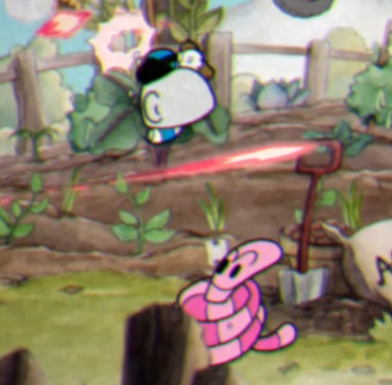

You could say that it's like a double jump, but only if you can actually parry something pink - although the main use besides getting a better rank [and progressing in a stage or boss that requires using the parry for survival] is that each parry gives you an instant EX card.
With one card, you can use your EX shot that varies depending of your weapon for more damage, and with five cards [the max] + a Super equipped [once you unlock the first one], a particular Super move, with the first one being this huge horizontal beam of wind for even more damage.
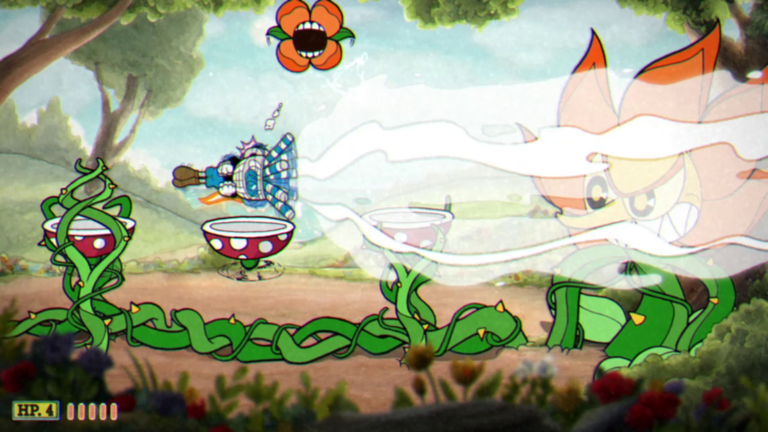
On top of that, if you are playing in co-op, you can also try to keep saving your partner by parrying their soul when they die, as this instantly revives them with one HP - and both players can keep saving each other like that as long as there's one of them alive to parry the other to be able to survive longer against a boss.
...Although for each save each player gets, their soul will move upwards faster - so eventually saving your partner with a soul parry may become unfeasible if they didn't already happen to die high enough on screen to be unreachable.
Standard run-and-gun stages have five coins each, which if you pick up and succesfully reach the end of the stage, you'll get to keep for using at the shop, which offers alternate weapons to equip [you get two weapon slots to switch between in-game as well] and charms that give you an extra benefit when equipped [but you only get one charm slot].
Sounds like you have a lot to work with to make things easy, right?
Trust me, you will not survive if you are playing through this blind. Although you CAN definitely learn to make good work of it with enough experience with the bosses AND the loadout you can get as you progress, but in any case, what better thing to exemplify that first timer frustration than with...
The conundrum of a dozen bosses

There's a good reason why Cuphead is often referred to as a boss rush game, as the majority of the game is comprised of boss fights. And if you want to defeat them, you'll need to pay attention to how bosses attack - their animations before specific attacks, how those attacks work, how to avoid them...and all of this is things that you will learn as you are defeated by them over and over.
If there's something that Cuphead thankfully doesn't inherit from its run-and-gun ancestors in old-school difficulty, is that you encounter these stages [bosses or not] in their own spots on the hub world, meaning that rather than going through an entire game while avoiding any deaths on one go, you can keep retrying any stage or boss that defeats you immediately.
The core of how bosses work though reminds me of the Punch Out games, as the bosses first seem to rely in telegraphed attacks or keeping distance to not get caught off guard, but their variety of attacks often opens up whenever you progress into their different phases, sometimes even transforming in different forms that demand you to change your approach.

That one flower boss with that well known song is a good example to start with although its a boss you'd face near the end of the first isle:
- If it clasps its hands together, its going to throw three nuts that go straight where you used to be OR a boomerang thing
- If it turns into this crank shooting upwards, then seeds are going to drop from above and you have to avoid those AND the things that come off those when they land. One of these will always be pink, meaning it can be parried.
- And if it winds up by leaning back...then its going to stretch its face full-screen width - something you'll only dodge by staying on the floor - or if it does the animation while laying low, above the platforms.
And facing this boss on your own at a first visit may look like dying to attacks you weren't prepared to react for, getting too close when it uses its ranged attacks or not getting out of the way in time, or even jumping by accident into those seeds that drop from above.
The way you can put together the pieces to deal with it afterwards is to recognize those animations that telegraph specific attacks, learning how each attack behaves to dodge them, and then execute by dealing with those consistently each time you can react to whatever the boss prepares to do in time.
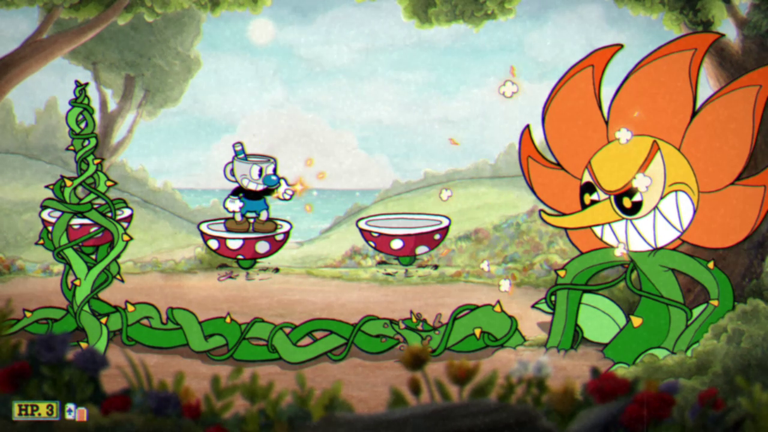
...Then the second half/phase of the boss switches things up a notch - and if you can't tell what happened the first time you get caught off guard in that phase, then pay attention to your surroundings to see where things can come from to kill you and learn to avoid them. A bit of trial-and-error may be needed, but nothing too overwhelming for being in the first island.
Trying to learn how bosses attack to then understand, read and react appropiately each time is the vital cycle of fighting bosses in Cuphead, and with the first batch of bosses in particular, you may go from getting bumrushed by Goopy Le Grande or the Root Pack, to consistently dismantling them due to their easily avoidable attacks when you see how they telegraph them or move around the stage.
It is in the variety of them though that the game will sooner or later start to really get you, not only when bosses start to have more attacks that have similar if not exact animations [forcing you to actually be ready to react to one out of many possible attacks rather than always the same one] but also start layering two or more attacks at the same time to dodge - you couldn't expect the bosses to always stick to one attack on the screen at a moment, right?
And that can also be stacked on top of bosses that mess with the floor in some phases, if not from the very beginning, adding an extra layer of making sure you always land on safe ground - falling off the screen only takes off one health point, but as hit points are valuable AND falling off means death if you are on your last legs, you do not want to neglect this.
That three headed dragon was the first boss that really had me and my brother quite tilted when it stacks its variety of attacks and phases with constantly moving clouds - truly a boss to cap off the second island of the game.
But what if you were to suddenly get thrown into a plane fight?
There's are shoot-em-up bosses in my run-and-gun game?
Certain bosses will be fights on plane rather than on ground, having you shoot down the boss and certain enemies while you dodge anything that the boss throws at you - still retaining the parry ability for anything bright pink.
Rather than a dash, you get a mini-plane transformation when you hold the dash button, which lets you move faster and makes you smaller, VERY useful for dodging hard patterns on a pinch...but is hampered in the damage AND range department by having a small ranged peashooter, meaning that you'll often want to switch back to big plane whenever you have space to [or risk dodging as the big plane to keep dealing damage].
And to put it simply, these will be the ones where you'll have to rely the most on reactions, as while most bosses still have tells for specific attacks, not only some attacks and hazards won't have any tells to anticipate ahead of time, but you'll also be forced to always be on your guard for pellets covering up the screen in order to move out of the way.
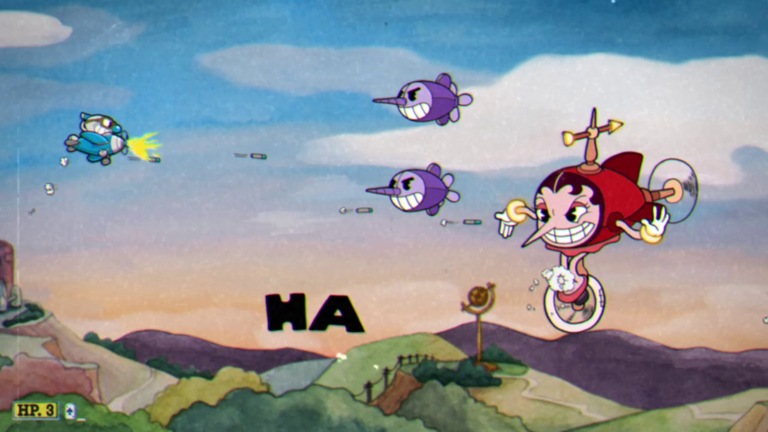
Despite this boss here being the first out of the plane bosses, it won't let up at all for any careless players, as most of the danger comes from hazards that show up from off-screen and telegraphed attacks from her transformations that are quite dangerous if you haven't learned how to prepare for at least once. You can sure see how these can get even harder than this later on.

Before going to the final thoughts, mentioning some of the bumps on the road and wins ahead of them, I do have to talk a bit about those standard run-and-gun stages I mentioned.
Wait, I have to get out of here
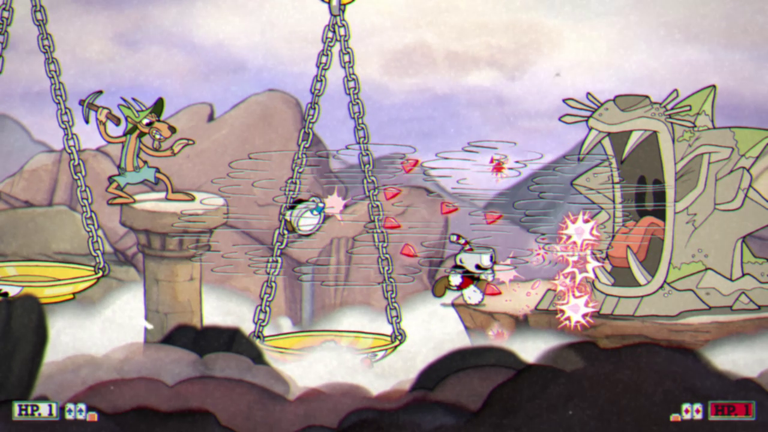
The run-and-gun stages definitely carry that same trial-and-error inducing energy the bosses have, as beyond the changing terrain of these stages forcing you to be ready to airdash whenever a platform is clearly not reachable with just a single jump, enemies will be plentiful, there's always a mini-boss at the end of each stage to deal with, and most coins are either somewhat hidden in plain sight with background elements or are quite out of the way - requiring a parry jump from something to reach or a well-timed air dash to pick up without falling off.
There's still a few that are easy to pick up, but you may forget to whenever you are dying enough times to the point that the one and only thing you want to do already is to just get through the damn levels.

These are far and few between, especially for the game not being THAT long if you can get the hang of the bosses steadily, but always make for a rude awakening when you have to rewire your brain into actually running and gunning through a scrolling stage...which can be even more messy if you are playing in co-op as the camera tries to center in both players rather than always centering on the one that's most ahead, so either both have to play at a similar pace or have to sometimes wait for each other to not go into a section with less visiblity.
Or just book it to the end if the other player dies at an inconvenient or impossible place to rescue them from.
And how was the whole journey like?
Well, in Co-op, there's absolutely some fun to be had between being able to clutch each other from death if the screen fills up with enough junk to kill one of both players out of nowhere, as well as allowing for some new strategies [like having one player focus on a boss while the other shoots down enemies spawning in, or covering enemy spawns from different sides], and while it is noticeable how the bosses are made to last longer if both players are still alive, the payoff for making it far in co-op and only having just the final phase left of a boss or stage is satisfying.
As the boss extra resistance gets removed when one player is left [or you have the camera left to a single player if the other one bites the dust in a run-and-gun stage], getting used to trying to endure the boss as a team gives you the chance to cap them off faster than before thanks to the perceived extra damage you deal [and the wider, centered view from running and gunning alone].
My brother definitely had some lone survivor finishes [Beppi, Phantom Express, Mortimer, Esther, the DLC final boss] while I also had my popoffs against him when a hilarious amount of times where I was left alone he sometimes said "we're doomed" - only for me to do get it done in THAT one attempt [like two or three run and gun stages, Silverhand, Devil], although there were two bosses where he cheered and even high-fived over my clutch finish [King Dice because I was WAY more consistent with parrying his cards, and Hounding Aces because I immediately figured out how to clock the phase with the screen tilting when I noticed the colored projectiles having a consistent pattern].
But you ain't going to tell me that there's not something satisfying about defeating the boss while both being alive, which was the case in most bosses, but I still remember our joy when we finally killed Grim Matchstick after relying HARD on the parry revives as we kept getting killed individually by the final phase's flamethrower attack and how that was somehow less strenous to survive in that specific condition than the second phase of that boss.
And that whole experience with the bosses would carry over to my attempts at tackling the bosses in Expert [which you only get when you beat the game/DLC] alone, as I'd definitely need the extra screen estate and damage from playing solo because trying to go there in co-op is a bad idea unless both players are THAT consistently good.
I already knocked four of the five bosses in the first island in Expert, but knowing that Hilda Berg and Cagney Carnation took me quite a handful of attempts to bury, I definitely feel like things will ramp up quite a notch whenever I get to the bosses that really tilted me and my brother in the Regular difficulty.
But if I do end up going through the whole thing in Expert in one piece, perhaps I could go about how I fared with those bosses in detail. Until then though, I can definitely say that Cuphead was quite the satisfying game to play through - having a steep challenge to overcome and adapt for maximum satisfaction being quite the value for the game actually being surprisingly short if you were to try to run through it as a marathon if you have mastered it to a high degree.
See you next time, and thanks for reading.

Spanish translation with DeepL. All screenshots were captured by myself.
Español

Recientemente terminé Cuphead en modo cooperativo, tanto el juego base como el DLC, así que puedes estar seguro de que tengo mucho que contar sobre toda la experiencia.
Cuphead destaca a primera vista por ser un juego impresionante en cuanto a cómo recrea la sensación de los dibujos animados con personajes elásticos y todos los jefes tienen muchas animaciones mientras luchas contra ellos, lo que también se debe al minucioso esfuerzo de dibujar a mano TODAS esas animaciones para darles mayor autenticidad [coloreadas digitalmente por motivos prácticos, pero el efecto sigue siendo el mismo].
... Y lo siguiente que notarás cuando lo pruebes es cómo te hará sufrir, porque Cuphead es un juego que no solo es de la vieja escuela en su presentación, sino también en su dificultad: la mayoría de los jefes no se andan con rodeos.
Ese desafío es algo que se ha convertido en el sello distintivo de la reputación de Cuphead: Morirás muchas veces a manos de muchos jefes, pero si estás dispuesto a soportar el proceso de prueba y error, practicando con ciertos jefes y manteniendo tus reflejos agudos, podrás superarlo todo y obtener un resultado satisfactorio, lo cual es clave en un juego que se propone ofrecer un desafío y que, a primera vista, parece brutal sin motivo.
Pero para superar esa dificultad, primero debería hablar de las armas para el éxito que se te proporcionan.
Dispara, parrea el rosa, no toques nad
Tanto Cuphead como Mugman son sorprendentemente móviles en comparación con lo que cabría esperar al oír que el juego es como un run-and-gun, cuando franquicias como Contra y Metal Slug a menudo solo te dejan con tu arma y correr + saltar, ya que también tienen un dash y un air dash para esquivar ataques.
La novedad más singular que ofrece Cuphead es sin duda el Parry: al pulsar Jump de nuevo mientras estás en el aire, realizarás una palmada rosa que, si la utilizas sobre CUALQUIER COSA que sea de color rosa brillante [primero verás balas rosas, pero tarde o temprano te encontrarás con algo más que eso], rebotarás hacia arriba en lugar de ser golpeado o atravesarlo.


Se podría decir que es como un doble salto, pero solo si realmente puedes parar algo rosa, aunque el uso principal, además de conseguir una mejor clasificación [y progresar en una fase o jefe que requiere usar la parry para sobrevivir], es que cada parry te da una carta EX instantánea.
Con una carta, puedes usar tu disparo EX, que varía según tu arma, para infligir más daño, y con cinco cartas [el máximo] + un Super equipado [una vez que desbloqueas el primero], un movimiento Super concreto, siendo el primero un enorme rayo de viento horizontal para infligir aún más daño.

Además, si estás jugando en modo cooperativo, también puedes intentar salvar a tu compañero parando su alma cuando muera, ya que esto lo revive instantáneamente con un punto de vida, y ambos jugadores pueden seguir salvándose mutuamente de esta manera mientras haya uno de ellos vivo para parar al otro y poder sobrevivir más tiempo contra un jefe.
...Aunque por cada salvación que consiga cada jugador, su alma se moverá más rápido hacia arriba, por lo que, al final, salvar a tu compañero con una parry de alma puede resultar inviable si no ha muerto lo suficientemente alto en la pantalla como para ser inalcanzable.
Las fases estándar de correr y disparar tienen cinco monedas cada una, que si recoges y llegas con éxito al final de la fase, podrás conservar para usar en la tienda, que ofrece armas alternativas para equipar [también tienes dos ranuras de armas para cambiar en el juego] y amuletos que te dan un beneficio adicional cuando los equipas [pero solo tienes una ranura para amuletos].
Parece que tienes mucho con lo que trabajar para facilitar las cosas, ¿verdad?
Créeme, no sobrevivirás si juegas a ciegas. Aunque definitivamente PUEDES aprender a hacerlo bien con suficiente experiencia con los jefes Y el equipamiento que puedes conseguir a medida que avanzas, pero en cualquier caso, ¿qué mejor manera de ejemplificar esa frustración de principiante que con...
El enigma de una docena de jefes

Hay una buena razón por la que Cuphead se conoce a menudo como un juego de jefes finales, ya que la mayor parte del juego consiste en combates contra jefes finales. Y si quieres derrotarlos, tendrás que prestar atención a cómo atacan los jefes: sus animaciones antes de ataques específicos, cómo funcionan esos ataques, cómo evitarlos... y todo esto son cosas que aprenderás a medida que te derroten una y otra vez.
Si hay algo que Cuphead, afortunadamente, no hereda de sus antecesores de la vieja escuela en cuanto a dificultad, es que te encuentras con estas fases [con jefes o sin ellos] en sus propios lugares dentro del mundo central, lo que significa que, en lugar de tener que pasar todo el juego evitando morir ni una sola vez, puedes volver a intentar cualquier fase o jefe que te haya derrotado inmediatamente.
Sin embargo, el funcionamiento básico de los jefes me recuerda a los juegos Punch Out, ya que al principio parecen basarse en ataques previsibles o en mantener la distancia para no ser sorprendidos, pero su variedad de ataques a menudo se amplía a medida que avanzas en sus diferentes fases, a veces incluso transformándose en diferentes formas que te obligan a cambiar tu estrategia.

Ese jefe flor con esa canción tan conocida es un buen ejemplo para empezar, aunque es un jefe al que te enfrentarás cerca del final de la primera isla:
- Si junta las manos, lanzará tres nueces que irán directamente donde estabas tú O una especie de boomerang.
- Si se convierte en una manivela que dispara hacia arriba, caerán semillas desde arriba y tendrás que esquivarlas Y a las cosas que salen de ellas cuando aterrizan. Una de ellas siempre será rosa, lo que significa que se puede parar.
- Y si se inclina hacia atrás... entonces estirará su cara a todo lo ancho de la pantalla, algo que solo podrás esquivar quedándote en el suelo, o si hace la animación mientras está agachado, por encima de las plataformas.
Y enfrentarte a este jefe por tu cuenta en tu primera visita puede parecer que vas a morir por ataques para los que no estabas preparado, por acercarte demasiado cuando usa sus ataques a distancia o por no apartarte a tiempo, o incluso por saltar accidentalmente sobre esas semillas que caen desde arriba.
La forma de reunir las piezas para lidiar con ello después es reconocer esas animaciones que anuncian ataques específicos, aprender cómo se comporta cada ataque para esquivarlos y luego ejecutarlos lidiando con ellos de forma consistente cada vez que puedas reaccionar a tiempo ante lo que el jefe se disponga a hacer.

...Entonces, la segunda mitad/fase del jefe cambia un poco las cosas, y si no sabes qué pasó la primera vez que te pilló desprevenido en esa fase, presta atención a tu entorno para ver de dónde pueden venir las cosas que te matan y aprende a evitarlas. Puede que sea necesario un poco de prueba y error, pero nada demasiado abrumador para estar en la primera isla.
Intentar aprender cómo atacan los jefes para luego comprender, leer y reaccionar adecuadamente cada vez es el ciclo vital de la lucha contra los jefes en Cuphead, y con el primer grupo de jefes en particular, puedes pasar de ser abrumado por Goopy Le Grande o el Root Pack, a desmantelarlos constantemente debido a sus ataques fácilmente evitables cuando ves cómo los telegrafían o se mueven por el escenario.
Sin embargo, es en la variedad de estos donde el juego tarde o temprano empezará a ponerte realmente a prueba, no solo cuando los jefes empiezan a tener más ataques con animaciones similares, si no idénticas [obligándote a estar realmente preparado para reaccionar ante uno de los muchos ataques posibles en lugar de siempre ante el mismo],sino también cuando empiezan a combinar dos o más ataques al mismo tiempo para esquivarlos. No puedes esperar que los jefes siempre se limiten a un solo ataque en pantalla, ¿verdad?
Y eso también se puede acumular sobre los jefes que alteran el suelo en algunas fases, si no desde el principio, añadiendo una capa extra para asegurarte de que siempre aterrizas en terreno seguro: caer fuera de la pantalla solo te quita un punto de salud, pero como los puntos de vida son valiosos Y caer significa la muerte si estás en tus últimas, no querrás descuidar esto.
Ese dragón de tres cabezas fue el primer jefe que realmente nos tuvo a mi hermano y a mí bastante nerviosos cuando acumula su variedad de ataques y fases con nubes en constante movimiento; verdaderamente un jefe para rematar la segunda isla del juego.
Pero, ¿y si de repente te vieras envuelto en una pelea en un avión?
¿Hay jefes de disparos en mi juego de correr y disparar?
Algunos jefes se luchan en el aire en lugar de en tierra, y tienes que derribar al jefe y a ciertos enemigos mientras esquivas todo lo que el jefe te lanza, conservando la capacidad de parar cualquier cosa de color rosa brillante.
En lugar de una carrera, obtienes una mini transformación de avión cuando mantienes pulsado el botón de carrera, lo que te permite moverte más rápido y te hace más pequeño, MUY útil para esquivar patrones difíciles en un apuro... pero se ve obstaculizado en cuanto a daño y alcance por tener un pequeño lanzador de guisantes, lo que significa que a menudo querrás volver al avión grande siempre que tengas espacio para hacerlo [o arriesgarte a esquivar como el avión grande para seguir infligiendo daño].
Y, en pocas palabras, estas serán las situaciones en las que más tendrás que confiar en tus reflejos, ya que, aunque la mayoría de los jefes siguen teniendo indicios que anuncian ataques específicos, no solo algunos ataques y peligros no tendrán indicios que te permitan anticiparte, sino que también te verás obligado a estar siempre alerta ante las balas que cubren la pantalla para poder esquivarlas.

A pesar de que este jefe es el primero de los jefes del avión, no dará tregua a los jugadores descuidados, ya que la mayor parte del peligro proviene de los peligros que aparecen fuera de la pantalla y de los ataques telegrafiados de sus transformaciones, que son bastante peligrosos si no has aprendido a prepararte para ellos al menos una vez. Seguro que más adelante verás cómo estos pueden ser aún más difíciles que esto.

Antes de pasar a las reflexiones finales, mencionando algunos de los obstáculos en el camino y las victorias que les esperan, tengo que hablar un poco sobre esas etapas estándar de correr y disparar que mencioné.
Espera, tengo que salir de aquí

Las fases de correr y disparar tienen la misma energía de prueba y error que los jefes, ya que, además del terreno cambiante de estas fases que te obliga a estar listo para hacer un airdash cada vez que una plataforma no es claramente alcanzable con un solo salto, los enemigos son abundantes, siempre hay un minijefazo al final de cada fase con el que lidiar, y la mayoría de las monedas están algo ocultas a simple vista entre los elementos del fondo o están bastante apartadas, lo que requiere un salto con parry desde algo para alcanzarlas o un salto aéreo en el momento oportuno para recogerlas sin caerse.
Todavía hay algunas que son fáciles de recoger, pero es posible que te olvides de hacerlo cuando mueres tantas veces que lo único que quieres es superar los malditos niveles.

Estos casos son muy poco frecuentes, sobre todo porque el juego no es TAN largo si consigues dominar a los jefes con soltura, pero siempre suponen un duro despertar cuando tienes que reprogramar tu cerebro para correr y disparar a través de una fase de desplazamiento... lo que puede ser aún más complicado si estás jugando en modo cooperativo, ya que la cámara intenta centrarse en ambos jugadores en lugar de centrarse siempre en el que va más adelantado, por lo que o bien ambos tienen que jugar a un ritmo similar o a veces tienen que esperarse el uno al otro para no entrar en una sección con menos visibilidad.
O simplemente correr hasta el final si el otro jugador muere en un lugar inconveniente o imposible de rescatar.
¿Y cómo fue todo el viaje?
Bueno, en el modo cooperativo, es muy divertido poder salvarse mutuamente de la muerte si la pantalla se llena de basura suficiente como para matar a uno de los dos jugadores de repente, además de permitir algunas estrategias nuevas [como que un jugador se centre en un jefe mientras el otro derriba a los enemigos que aparecen, o cubrir las apariciones de enemigos desde diferentes lados], y aunque se nota que los jefes están hechos para durar más si ambos jugadores siguen vivos, la recompensa por llegar lejos en el modo cooperativo y tener solo la fase final de un jefe o una etapa es satisfactoria.
Como la resistencia extra del jefe se elimina cuando queda un solo jugador [o la cámara se centra en un solo jugador si el otro muere en una fase de correr y disparar], acostumbrarse a intentar aguantar al jefe en equipo te da la oportunidad de acabar con él más rápido que antes gracias al daño extra percibido que infliges [y a la visión más amplia y centrada que se obtiene al correr y disparar solo].
Mi hermano definitivamente tuvo algunos finales de superviviente solitario [Beppi, Phantom Express, Mortimer, Esther, el jefe final del DLC], mientras que yo también tuve mis momentos de gloria contra él, cuando en una cantidad hilarante de ocasiones en las que me quedé solo, él a veces decía «estamos condenados» , solo para que yo lo consiguiera en ESE único intento [como dos o tres fases de correr y disparar, Silverhand, Devil], aunque hubo dos jefes en los que él me animó e incluso me dio un choque de manos por mi final decisivo [King Dice porque yo era MUCHO más consistente a la hora de parar sus cartas, y Hounding Aces porque inmediatamente descubrí cómo cronometrar la fase con la pantalla inclinada cuando me di cuenta de que los proyectiles de colores tenían un patrón constante].
Pero no me dirás que no hay algo satisfactorio en derrotar al jefe mientras ambos están vivos, lo cual era el caso en la mayoría de los jefes, pero aún recuerdo nuestra alegría cuando por fin matamos a Grim Matchstick después de depender MUCHO de revivirnos con el parry, ya que nos seguían matando individualmente con el ataque lanzallamas de la fase final, y cómo de alguna manera era menos agotador sobrevivir en esa condición específica que en la segunda fase de ese jefe.
Y toda esa experiencia con los jefes se trasladaría a mis intentos de enfrentarme a los jefes en Expert [que solo se consigue cuando se supera el juego/DLC] en solitario, ya que sin duda necesitaría el espacio adicional en pantalla y el daño de jugar en solitario, porque intentar hacerlo en modo cooperativo es una mala idea a menos que ambos jugadores sean TAN buenos de forma constante.
Ya derroté a cuatro de los cinco jefes de la primera isla en el modo Experto, pero sabiendo que me costó bastante derrotar a Hilda Berg y Cagney Carnation, definitivamente siento que las cosas se pondrán bastante difíciles cuando llegue a los jefes que realmente nos pusieron en aprietos a mi hermano y a mí en el modo Normal.
Pero si al final consigo pasar todo el juego en modo Experto sin sufrir ningún daño, quizá pueda contar con detalle cómo me fue con esos jefes. Hasta entonces, puedo decir sin duda que Cuphead es un juego muy satisfactorio, con un gran desafío que superar y al que adaptarse para obtener la máxima satisfacción, lo que le da mucho valor, ya que en realidad es sorprendentemente corto si intentas pasártelo como una maratón una vez que lo has dominado a un alto nivel.
Hasta la próxima y gracias por leer.

Traducción al español hecha con DeepL. Todas las fotos capturadas por mí.
I tried it when it released, gave up pretty early, thinking the difficulty is only going to rise from then on lol. To be honest, I didn't give it enough time to grow on me.
Never tried the Co-op mode, it could be really fun. Might try it again with a friend to see how it feels.
Very well written post as always, bro.
Thanks for reading and for the comment :)
It may have been noticeable from the detail I took on detailing the gameplay here, but we REALLY liked how the game had us learning and then engaging in a challenge that was up to par with our expectations while not being absurdly punishing like we've seen in a few other games (Serious Sam 3 BFE's final level...)
Co-op mode can sure be super fun if you have someone else to play it with that can be on your level, more so if each other can clutch a dead player through the parry, but it does make fights slightly longer to accomodate for both players - so you two would have to be willing to practice enough to go through all those bosses
That said, I forgot to mention there's also a Simple mode for almost all bosses, which does simplify most phases and may remove at least one, but you can't get to the final challenges of the game unless you beat all the bosses in Regular instead (since that's the only way you get the contracts for a boss's soul). Still could be worth a try if needing a bit of an easier taste of each boss before trying to jump into the regular challenge.